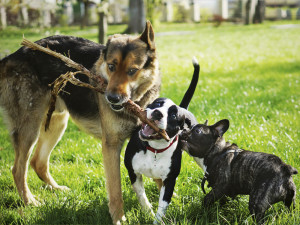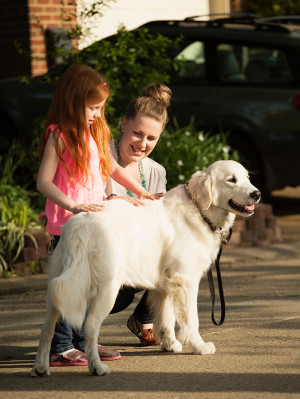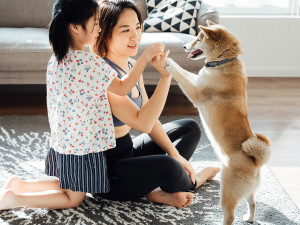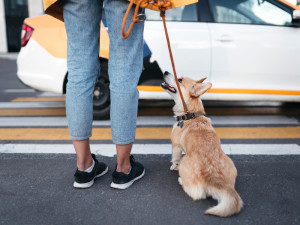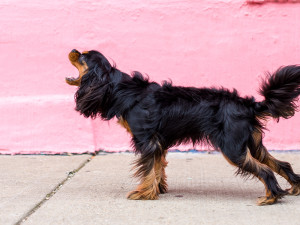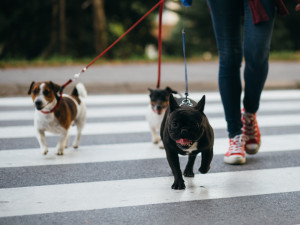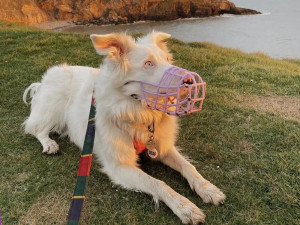How to Get Your Dog to Stop Resource Guarding Their Stuff
If your dog growls when you get near their food or toys, read this right now.
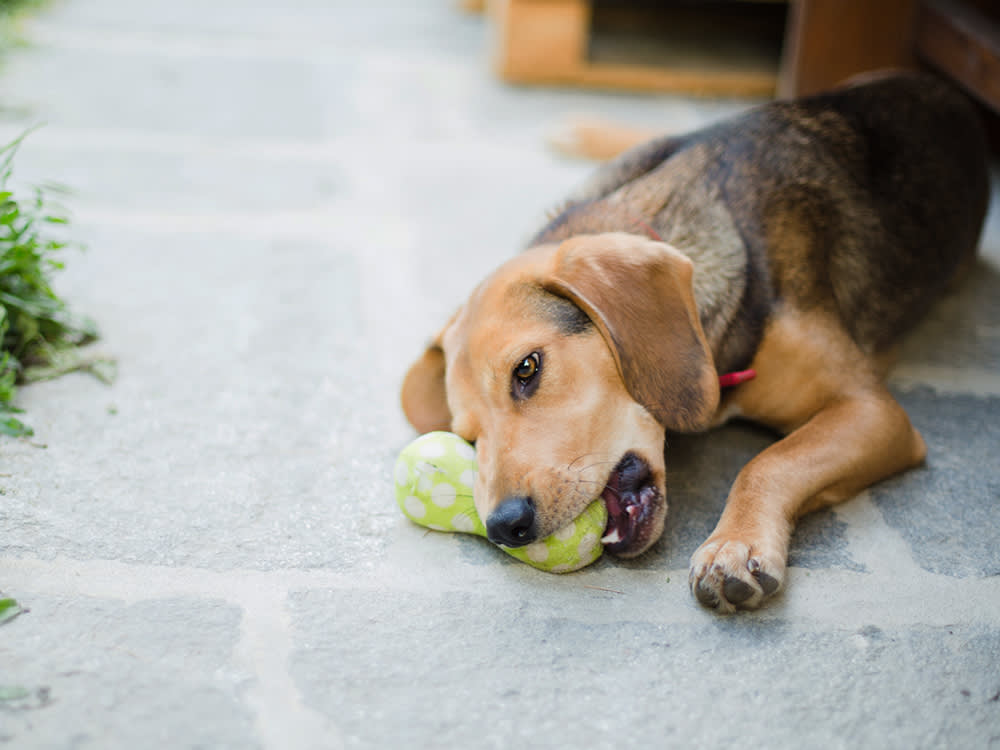
share article
In this Article:
What Is Resource Guarding?opens in a new tab What Causes Resource Guarding In Dogs?opens in a new tab What Are the Signs Of Resource Guarding?opens in a new tab How to Prevent Resource Guardingopens in a new tab How to Stop Resource Guardingopens in a new tab Living With Resource Guardingopens in a new tab
Does your dog growl and show their teeth if you come near them while they’re chewing on a bone? Do they stiffen if you try to take a toy from them? If you walk near them while they’re eating, do they eat faster?
If you answered “yes” to any of these questions, your dog is exhibiting behavior known as “resource guarding,” which is any behavior that a dog displays to convince others to stay away from something they consider valuable. This survival instinct might be useful for dogs in the wild, but it’s not ideal for a member of your fam. Keep reading to learn more about resource guarding in dogs — including how to get them to stop.
What is resource guarding in dogs?
Resource guarding is a common and normal part of dog behavior. Signs of resource guarding in dogs include behaviors such as growlingopens in a new tab, tooth displaying, stiffening, frantic eating, glaring, snapping, barking, leaning over the resource to shield it, and biting. Dogs commonly guard food, toysopens in a new tab, treats, bones, rawhides, bedsopens in a new tab, and even another dog or a personopens in a new tab.
In many cases, resource guarding is subtle. A dog with a pig’s ear, for example, may turn their body to shield their precious treasure from anyone approaching, or they may pick it up and carry it to another room. They might put their paw on it or even give you a look that means something along the lines of “Don’t even think about it,” or “Please don’t take it away. I want it.” Few people are troubled by such mild forms of resource guarding.
Even though resource guarding can become far more serious, there’s some good news. One, there are ways to prevent it in most dogs. Two, behavior modification plans using counterconditioning and desensitizationopens in a new tab are easy to implement, and they are effective at improving the dog’s behavior. Three, many people choose to simply live with it, managing it as best they can. That may not sound very inspiring, but I consider any solution that keeps a dog at home and people safe while allowing a loving relationship between the two to flourish and grow to be a success.
What causes resource guarding in dogs?
When considering what triggers resource guarding in dogs, it’s essential to understand that this behavior does not have a single cause. Rather, there are various causes of resource guarding dog behavior, and there can even be multiple reasons for this behavior in an individual dog. Dogs who resource guard generally do so for one or more of the following reasons:
Genetics: Some dogs are genetically predisposedopens in a new tab to have trouble sharing and to act in a way that protects anything of value. Genetic tendencies may lead to dogs who guard their own items of value as well as those dogs who take a “What’s mine is mine, what’s yours is mine” approach to life.
Training: If dogs have repeatedly lost items of value because either a dog or a person regularly took them away, they may react by resource guarding going forward. Dogs with these experiences in the past have essentially been taught (trained!) that the only way to keep what they have is to guard it.
Changes in the household: Sudden resource guarding in dogs may occur because of changes in the family. For example, if a new dog who always takes, takes, takes joins the family, a dog may begin to resource guard as a protective measure. Resource guarding can also developopens in a new tab as a young dog matures.
Scarce resources: If there is currently not enough to go around or the dog experienced such a shortage in the past, resource guarding can be the result. If a dog has experienced not having enough food, or if there is only one toy or bone available, resource guarding is a strategy that allows them to have what they want or need. A dog who has experienced resource scarcity may always be a little fearful of not having enough, or may simply be in the habit of resource guarding, even though there are now plenty of toys, food, and bones available.
What are the signs of resource guarding in dogs?
Resource guarding in dogs can take many forms — some are so subtle it’s easy to overlook them, and some are so obvious you can’t miss them. A dog doesn’t have to be snarling or biting to be resource guarding. Any behavior that a dog uses to keep something of value rather than lose it to someone else is resource guarding behavior. Common behaviors that are signs of resource guarding in dogs include:
Intently watching others
Stiffening of the body
Putting a paw on the treasure
Taking the object further away or into another room
Hovering over the object
Shielding the item from view
Frantically and quickly eating the item (if edible) when anyone approaches
Staring
Growling
Tooth displaying
Snapping
Biting
How to prevent resource guarding
Dogs are often nervous about losing what they value. With that in mind, a key aspect of preventing resource guarding in dogs, including food-bowl aggressionopens in a new tab — its most common form — is to teach dogs to be happy when someone approaches or reaches for their treasure. Dogs who are happy in a particular context are a whole lot less likely to act aggressively.
Creating this positive emotional reaction is simple: Teach your dog to associate the approach of a person with treatsopens in a new tab. I advise people to walk toward their dog and toss a really good treat into the bowl or near their treasure. Once the dog is used to this, the next step is to walk over, pick up the bowl or the treasure, deliver a treat (in the bowl is fine), and then return the bowl or the treasure. It’s important to do this quickly — within a few seconds at most — so your dog doesn’t feel as if they’re being teased.
I suggest doing this only once or twice per session; even though your dog gets a treat, the interruption can still be irritating. (I imagine dogs in that situation feel like I do when a restaurant server refills my water glass every time I take a sip: mildly harassed.)
Other ways to prevent resource guarding include managing situations to avoid any opportunities for your dog to engage in this behavior. That includes being vigilant about removing and hiding items that your dog is likely to take and then guard. It also means that everyone in the family must avoid approaching or challenging the dog when they have food or a chew toy, or any other items that trigger their resource guarding behavior.
Avoid bad strategies
You may have been advised to put your hand in your dog’s food bowl or pick up the bowl and hold it. Unfortunately, this strategy is far more likely to lead to food-bowl aggression than to prevent it. Such actions are irksome, so it’s no surprise that many dogs will lose their temper eventually. While some dogs will never become resource guarders, even when provoked, others can be taught to be aggressive around their food. Some of the worst resource guarders I’ve ever seen were taught to be that way by their well-intentioned humans.
People accidentally teach dogs to guard their resources in other ways, as well. If your dog has a bone (or food or a shoe or the remote control) and you take it from them, they learn that they lose treasures unless they take action. To avoid that, instead of taking something from your dog, trade them for it. Hold a treat or other desirable object right by their nose, and if they drop the contraband, give them the offered item. This teaches them that they get paid for letting go of things (instead of getting mugged whenever they have something valuable.)
It’s very important to help your dog feel happy about releasing items and to actively avoid making it a negative experience. Trading is far better than a battle, and it’s very effective, especially if they’re “trading up,” or getting something better than what they surrendered.
Another strategy is to have your dog drop the object, give them a treat, and then give them back the item. This helps them learn that it’s worthwhile to release things. I like to teach the cue “drop it.” So, if a dog gets something they shouldn’t have, I can ask them to release it before they damage it — or themselves.
How to stop resource guarding behavior
Giving extra treats when your dog has something of value is a useful way to prevent resource guarding, but it can also be used to stop an existing behavior. (If your dog has previously bitten or threatened anyone, I advise having a behaviorist supervise this interaction.) “Counterconditioning” is the technical term for the strategy of teaching your dog to associate something they like, such as treats, with you approaching, reaching for, or taking something they have. “Desensitization” is the term for getting your dog used to you approaching, etc. when they have something they consider a treasure.
Start by standing outside the dog’s reaction zone and tossing high-quality treats to them. The goal is to make them happy that a person is present when they have a treasure. This change in their emotional response is what will lead to a change in their behavior. The closer you get, the more intense the situation will become. The intensity will also increase if the dog has a more highly valued item, or if you approach, reach for, or pick up the resource.
Work at each level of intensity until your dog is comfortable, and only then progress to something harder. The highest-intensity context is to approach your dog and take something they value highly. Success can only be achieved by gradually working toward that goal and requires many steps and many repetitions over a period of weeks and months.
When it comes to resource guarding in dogs, training is always important for improving the behavior. Using counterconditioning and desensitization is a great way to train your dog to act differently in situations that used to lead to resource guarding and possibly even aggression. It’s a kindness to teach them to be able to handle — and even to enjoy!— people coming near them or reaching for them when they have something of value. Helping them to feel OK about what you’re doing is the best way to improve their behavior in such situations.
Living with resource guarding
Despite the challenges of sharing a home with a dog who guards resources, it’s common for people to choose to live with it. People who have a dog with this predilection know when to expect the behavior, and they simply avoid going near their dog when they have a valued item. This predictability may account for the lack of concern many have about resource guarding. Of course, predictability varies depending on the household. A single person who rarely entertains is in a very different situation than a family with five small kids opens in a new tabwho have additional children over to play nearly every day.
Years ago, the standard view was that a dog shouldn’t be approached at mealtimes or when they are chewing a bone or playing with a favorite toy, and there’s a lot of good sense in that. If you don’t bother your dog while they’re eating, and you purposely avoid going near them when they have a bone or other treasure, you will avoid trouble.
Life with a dog who allows anyone to take anything away from them is pretty easy, but that’s really a lot to ask of even the dearest, sweetest dog on the planet. There are, of course, dogs who are as unlikely to guard resources as they are to calculate Schrödinger’s wave equation. But we shouldn’t assume that dogs who are lovely — but perhaps not so nonchalant about having resources taken from them — are bad.
With dogs who are at risk of causing injury, it’s obviously critical to have some way to keep everyone safe. You can deal with this problem by preventing situations that trigger problem behavior (particularly aggression) and with behavior modification that alters how your dog behaves when they have something of value. How important it is to train your dogs not to resource guard is an individual decision — you might be highly committed or willing to simply live with it.
The bottom line: Resource guarding is common, though less than desirable, dog behavior. I’m not excusing it or saying that it’s not a problem, but like barking and chewing, it is accepted by many people as part of living with a dog — although clearly, it’s nobody’s favorite part. Although it can be changed and improved with behavior modification, tons of people choose to accept it, figuring that life is too short to demand perfection of their best friend.
When should I seek professional help for resource guarding?
Assistance from a professional is essential if the resource-guarding dog has bitten or if there are children in the household. Even if there haven’t been any injuries and even if there are no kids present, seek professional help for resource guarding if you want to improve your dog’s behavior and prevent it from getting worse.
Resource guarding behavior in dogs can be stressful to live with, and a qualified canine behaviorist or dog trainer can help. They will teach you how to manage situations to avoid resource guarding problems, and instruct you about training exercises that will reduce the resource-guarding behavior.
FAQs (People also ask):
How can I safely take something away from my dog without triggering aggression?
Strategies for safely taking something away from your dog include: training your dog to “drop it” on cue, trading for an item they want even more, and tossing treats so they drop the item to eat the treats.
Are there specific exercises to reduce resource guarding?
Specific exercises to reduce resource guarding involve teaching your dog to associate people approaching, reaching for, and taking items of value away from them with receiving something good and feeling happy.
What should I do if my dog bites someone due to resource guarding?
If your dog bites while guarding resources, seek professional help from a qualified behaviorist or trainer immediately. In the meantime, prevent another incident by avoiding the situation that caused the issue.
References:

Karen B. London, PhD, CAAB, CPDT-KA
Karen B. London, Ph.D., is a Certified Applied Animal Behaviorist and Certified Professional Dog Trainer who specializes in working with dogs with serious behavioral issues, including aggression, and has also trained other animals including cats, birds, snakes, and insects. She writes the animal column for the Arizona Daily Sun and is an Adjunct Professor in the Department of Biological Sciences at Northern Arizona University. She is the author of six books about training and behavior, including her most recent, Treat Everyone Like a Dog: How a Dog Trainer’s World View Can Improve Your Lifeopens in a new tab.
Related articles
![Dog looks up at owner on a walk through the city]() opens in a new tab
opens in a new tab7 Ways to Stop Your Dog from Scavenging on Walks
If your dog tries to scarf down literally everything in sight, you need this advice.
![Dog barking on the sidewalk in front of a pink wall]() opens in a new tab
opens in a new tabHow to Fix Your Dog’s Non-Stop Barking
You can live in a quiet house again.
![Shiba inu dog sitting on kitchen counter in a trailer home]() opens in a new tab
opens in a new tabHow Do I Stop My Dog From Counter Surfing?
Celebrity dog trainer Victoria Stilwell’s pro tips for keeping paws off your charcuterie platter this holiday season.
![Tan Chihuahua dog laying on aqua rug looking down shamefully]() opens in a new tab
opens in a new tab“Why Is My Adult Dog Peeing In The House?”
How to re-housetrain a dog of any age.
![Dog walker crossing a street with three dogs]() opens in a new tab
opens in a new tabHow to Prepare Your Dog For Daycare and Dog Walkers
Set your pup up for success.
![White Shepherd mix dog wearing a pink muzzle while sitting on the grass with sunset cliffs and the ocean in the background]() opens in a new tab
opens in a new tabMuzzle Up Project Wants You to Remove Your Judgment Goggles When You See a Muzzled Dog
How the misunderstood training tool actually empowers dogs to be “happy, fulfilled, and living their best lives.”


